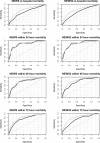Use of the first National Early Warning Score recorded within 24 hours of admission to estimate the risk of in-hospital mortality in unplanned COVID-19 patients: a retrospective cohort study
- PMID: 33619194
- PMCID: PMC7902318
- DOI: 10.1136/bmjopen-2020-043721
Use of the first National Early Warning Score recorded within 24 hours of admission to estimate the risk of in-hospital mortality in unplanned COVID-19 patients: a retrospective cohort study
Abstract
Objectives: Although the National Early Warning Score (NEWS) and its latest version NEWS2 are recommended for monitoring deterioration in patients admitted to hospital, little is known about their performance in COVID-19 patients. We aimed to compare the performance of the NEWS and NEWS2 in patients with COVID-19 versus those without during the first phase of the pandemic.
Design: A retrospective cross-sectional study.
Setting: Two acute hospitals (Scarborough and York) are combined into a single dataset and analysed collectively.
Participants: Adult (≥18 years) non-elective admissions discharged between 11 March 2020 and 13 June 2020 with an index or on-admission NEWS2 electronically recorded within ±24 hours of admission to predict mortality at four time points (in-hospital, 24 hours, 48 hours and 72 hours) in COVID-19 versus non-COVID-19 admissions.
Results: Out of 6480 non-elective admissions, 620 (9.6%) had a diagnosis of COVID-19. They were older (73.3 vs 67.7 years), more often male (54.7% vs 50.1%), had higher index NEWS (4 vs 2.5) and NEWS2 (4.6 vs 2.8) scores and higher in-hospital mortality (32.1% vs 5.8%). The c-statistics for predicting in-hospital mortality in COVID-19 admissions was significantly lower using NEWS (0.64 vs 0.74) or NEWS2 (0.64 vs 0.74), however, these differences reduced at 72hours (NEWS: 0.75 vs 0.81; NEWS2: 0.71 vs 0.81), 48 hours (NEWS: 0.78 vs 0.81; NEWS2: 0.76 vs 0.82) and 24hours (NEWS: 0.84 vs 0.84; NEWS2: 0.86 vs 0.84). Increasing NEWS2 values reflected increased mortality, but for any given value the absolute risk was on average 24% higher (eg, NEWS2=5: 36% vs 9%).
Conclusions: The index or on-admission NEWS and NEWS2 offers lower discrimination for COVID-19 admissions versus non-COVID-19 admissions. The index NEWS2 was not proven to be better than the index NEWS. For each value of the index NEWS/NEWS2, COVID-19 admissions had a substantially higher risk of mortality than non-COVID-19 admissions which reflects the increased baseline mortality risk of COVID-19.
Keywords: health & safety; health informatics; quality in health care.
© Author(s) (or their employer(s)) 2021. Re-use permitted under CC BY-NC. No commercial re-use. See rights and permissions. Published by BMJ.
Conflict of interest statement
Competing interests: None declared.
Figures


References
-
- Royal College of Physicians National Early Warning Score (NEWS): Standardising the assessment of acuteillness severity in the NHS - Report of a working party, 2012.
-
- NHS Royal College of physicians: NHS England approves use of national early warning score (news) 2 to improve detection of acutely ill patients, 2017. Available: https://www.rcplondon.ac.uk/news/nhs-england-approves-use-national-early...
Publication types
MeSH terms
LinkOut - more resources
Full Text Sources
Other Literature Sources
Medical
